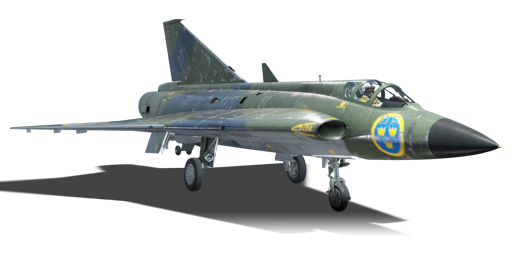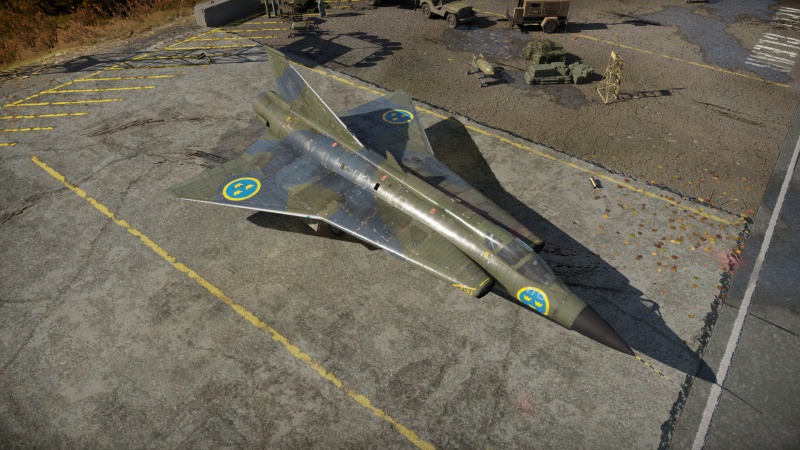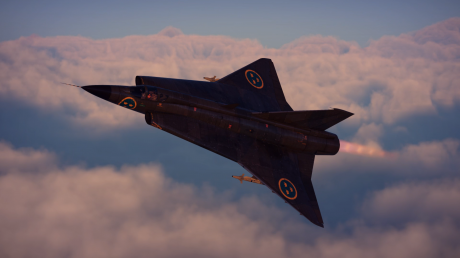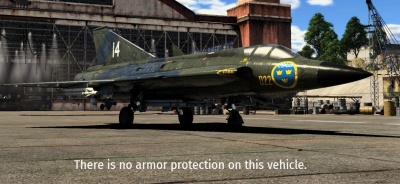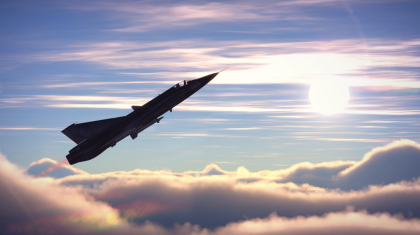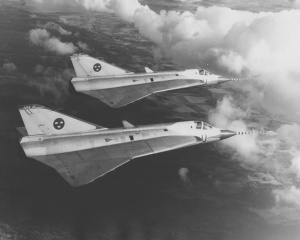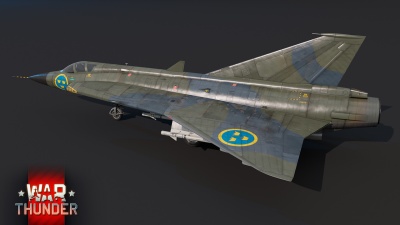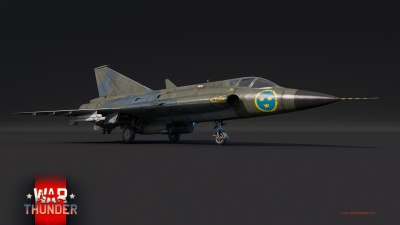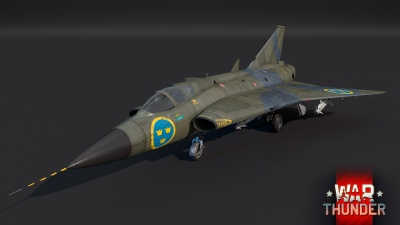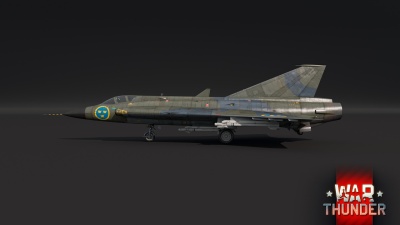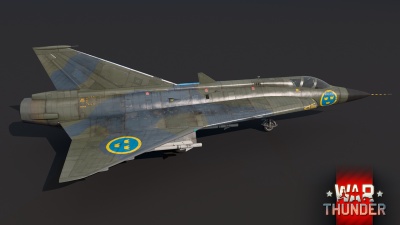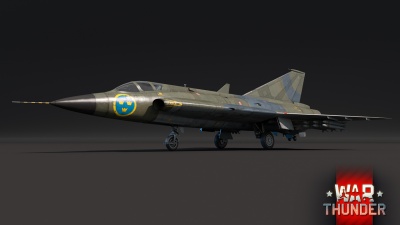Difference between revisions of "J35D"
m (→Flight performance) (Tag: Visual edit) |
Hakos Baelz (talk | contribs) m (→Offensive armament: Updating the page as per latest update.) (Tag: Visual edit) |
||
| Line 128: | Line 128: | ||
The '''''{{PAGENAME}}''''' is armed with: | The '''''{{PAGENAME}}''''' is armed with: | ||
| − | * 2 x 30 mm Akan m/55 cannons, wing-mounted ( | + | * 2 x 30 mm Akan m/55 cannons, wing-mounted (100 rpg = 200 total) |
| − | The {{PAGENAME}} is outfitted with two 30 mm Akan m/55 cannons, which are Swedish manufactured variants of the British [[ADEN (30 mm)|ADEN]] cannons. These two cannons offer a high burst mass and velocity at medium ranges. Although these guns are dangerous, they are quite limited by their ammunition count. | + | The {{PAGENAME}} is outfitted with two 30 mm Akan m/55 cannons, which are Swedish manufactured variants of the British [[ADEN (30 mm)|ADEN]] cannons. These two cannons offer a high burst mass and velocity at medium ranges. Although these guns are dangerous, they are quite limited by their ammunition count. Unlike the J32B, these cannons have 100 rounds each, giving the player a total of 200 shells. The cannons should be fired with caution in order to maximize the amount of damage they provide. Since the missiles are outdated RB24 missiles, a {{PAGENAME}} pilot needs to be prepared to engage most enemies with these cannons rather than suspended armaments. |
Another issue with the {{PAGENAME}} is the cannon placement. The two Akans are wing-mounted rather than center-mounted. This is a downgrade compared to the gun placement found on the earlier J32B since set convergence now plays a role. This makes the {{PAGENAME}} lose effectiveness at certain ranges since the target has the chance to fly between the shells, and when hitting a target, the shells are unlikely to concentrate to a singular point, lowering the amount of damage created. This placement creates difficulty in complex manoeuvres, since putting the plane sideways creates a vertical spread. A wise {{PAGENAME}} pilot will commence target practice with the guns prior to battle as they are important for the plane's overall survivability and combat effectiveness. | Another issue with the {{PAGENAME}} is the cannon placement. The two Akans are wing-mounted rather than center-mounted. This is a downgrade compared to the gun placement found on the earlier J32B since set convergence now plays a role. This makes the {{PAGENAME}} lose effectiveness at certain ranges since the target has the chance to fly between the shells, and when hitting a target, the shells are unlikely to concentrate to a singular point, lowering the amount of damage created. This placement creates difficulty in complex manoeuvres, since putting the plane sideways creates a vertical spread. A wise {{PAGENAME}} pilot will commence target practice with the guns prior to battle as they are important for the plane's overall survivability and combat effectiveness. | ||
Revision as of 13:00, 17 August 2021
Contents
Description
The J35D Draken is a rank VII Swedish jet fighter with a battle rating of 10.0 (AB), 10.3 (RB), and 10.7 (SB). It was introduced in Update 1.97 "Viking Fury".
The J35D is the first Swedish jet capable of Mach 2. The jet is highly agile and is the first plane in War Thunder capable of performing the famous "Cobra manoeuvre".
General info
Flight performance
The Saab J35D Draken is a highly agile interceptor of the Swedish aviation family. This interceptor uses a double delta wing-configuration and a powerful Avon engine to achieve both excellent high and low-speed performance at various altitudes. This aircraft is outfitted with two wing-mounted Akan m/55 auto-cannons and up to four RB24/RB24J missiles. Along with options for both anti-air and anti-ground rockets, the J35D becomes a versatile platform with a high potential thanks to unmatched manoeuvrability. Having the lowest stall speed of any supersonic jet (78 knots, 145 km/h, equivalent to the Ho 229 V3 and Bf 109 E), it has slightly more than twice the available lift-weight capacity of the MiG-21MF (115 knots, 210 km/h), the J35D comfortably dogfights any opponent who dares to challenge it in a 1v1.
The cost of this manoeuvrability is the large reduction in speed when turning. The J35D usually drops below 500 km/h airspeed when performing aggressive manoeuvres. This lack of speed usually leaves the J35D vulnerable to enemy attacks, since avoiding missiles or gunfire becomes a lot more difficult. This makes the J35D a unique flying experience where the player needs to be constantly aware of the current airspeed, while still avoiding dumping all speed at once. In order to maximize the stored speed, the J35D should be flown carefully. Aerial manoeuvres should be avoided and turning has to be done slowly. The efficiency of the J35D significantly increases when played with higher speeds. Although the plane becomes more sluggish at speeds close to 1,100 km/h, the J35D still manages to outmanoeuvre incoming missiles. Avoiding incoming homing devices usually leads to deceleration, but with careful planning, this speed can always be regained thanks to the strong acceleration the engine provides.
| Characteristics | Max Speed (km/h at 0 m - sea level) |
Max altitude (metres) |
Turn time (seconds) |
Rate of climb (metres/second) |
Take-off run (metres) | |||
|---|---|---|---|---|---|---|---|---|
| AB | RB | AB | RB | AB | RB | |||
| Stock | 2,055 | 2,003 | 12500 | 26.5 | 27.1 | 151.4 | 139.6 | 900 |
| Upgraded | 2,257 | 2,150 | 23.5 | 25.0 | 211.6 | 180 | ||
Details
| Features | |||||
|---|---|---|---|---|---|
| Combat flaps | Take-off flaps | Landing flaps | Air brakes | Arrestor gear | Drogue chute |
| X | X | X | ✓ | X | ✓ |
| Limits | ||||||
|---|---|---|---|---|---|---|
| Wings (km/h) | Gear (km/h) | Flaps (km/h) | Max Static G | |||
| Combat | Take-off | Landing | + | - | ||
| 0 | 500 | N/A | N/A | N/A | ~11 | ~5 |
| Optimal velocities (km/h) | |||
|---|---|---|---|
| Ailerons | Rudder | Elevators | Radiator |
| < 850 | < 700 | < 700 | N/A |
Engine performance
| Engine | Aircraft mass | ||||
|---|---|---|---|---|---|
| Engine name | Number | Basic mass | Wing loading (full fuel) | ||
| Svenska Flygmotor RM 6C | 1 | 8,105 kg | 208 kg/m2 | ||
| Engine characteristics | Mass with fuel (no weapons load) | Max Takeoff Weight | |||
| Weight (each) | Type | 6m fuel | 21m fuel | ||
| 1,400 kg | Afterburning axial-flow turbojet | 8,748 kg | 10,318 kg | 13,500 kg | |
| Maximum engine thrust @ 0 m (RB / SB) | Thrust to weight ratio @ 0 m (WEP) | ||||
| Condition | 100% | WEP | 6m fuel | 21m fuel | MTOW |
| Stationary | 5,575 kgf | 8,028 kgf | 0.92 | 0.78 | 0.59 |
| Optimal | 5,575 kgf (0 km/h) |
10,126 kgf (1,250 km/h) |
1.17 | 0.98 | 0.75 |
Survivability and armour
The J35D is one of the many high-rank planes entirely without protection, much like the F-4 Phantom series of fighters. Although the later variants of the Draken featured bird strike-proof cockpits, no Draken variant was fitted with armour plating or bulletproof glass. In-game, this downside can be quite hard to notice since higher rank vehicles tend to boast incredible amounts of firepower, making every hit incredibly devastating. A J35D pilot should, like every other pilot, avoid damages at all costs as any damage deteriorates the aircraft's performance and ability to stay in the fight.
Modifications and economy
Armaments
Offensive armament
The J35D is armed with:
- 2 x 30 mm Akan m/55 cannons, wing-mounted (100 rpg = 200 total)
The J35D is outfitted with two 30 mm Akan m/55 cannons, which are Swedish manufactured variants of the British ADEN cannons. These two cannons offer a high burst mass and velocity at medium ranges. Although these guns are dangerous, they are quite limited by their ammunition count. Unlike the J32B, these cannons have 100 rounds each, giving the player a total of 200 shells. The cannons should be fired with caution in order to maximize the amount of damage they provide. Since the missiles are outdated RB24 missiles, a J35D pilot needs to be prepared to engage most enemies with these cannons rather than suspended armaments.
Another issue with the J35D is the cannon placement. The two Akans are wing-mounted rather than center-mounted. This is a downgrade compared to the gun placement found on the earlier J32B since set convergence now plays a role. This makes the J35D lose effectiveness at certain ranges since the target has the chance to fly between the shells, and when hitting a target, the shells are unlikely to concentrate to a singular point, lowering the amount of damage created. This placement creates difficulty in complex manoeuvres, since putting the plane sideways creates a vertical spread. A wise J35D pilot will commence target practice with the guns prior to battle as they are important for the plane's overall survivability and combat effectiveness.
Suspended armament
The J35D can be outfitted with the following ordnance:
- Without load
- 2 x RB24 missiles
- 12 x m/56D rockets
- 38 x srak m/57B rockets
- 4 x RB24 missiles
- 2 x RB24 missiles + 12 x m/56D rockets
- 2 x RB24 missiles + 38 x srak m/57B rockets
- 4 x RB24J missiles
- 2 x RB24J missiles + 12 x m/56D rockets
- 2 x RB24J missiles + 38 x srak m/57B rockets
The J35D is able to carry 12 suspended m/56D unguided rockets for ground-strike purposes. These rockets have a TNT filler with the same penetration as the earlier m/49A found on the earlier ground-strike planes. The rockets fire individually starting from the left, and are placed in a vertical angle, These rockets are devastating against lighter vehicles at high tiers. Thanks to a single-fire system and good velocity, the effectiveness can be quite high if practised. But due to the J35D being only available for use at top-tier, these rockets have a very low chance of reliably working, since the targets are usually heavily armoured. The J35D lacks a ballistic missile computer and is easily countered by missile SPAA, making the J35D a bad pick for close air support in general. If the player feels the need for a challenge, the J35D is at the very least highly manoeuvrable, giving players the option to do several dangerous passes in a short period of time.
The J35D offers a pair of unguided m/57B rocket pods. These rockets are designed for bomber interception, and are very devastating against aerial targets. These rockets fire in pairs, in contrast to the single-fire m/56D rockets for ground-attack purposes. Being placed parallel with the plane, these rockets are comfortable to aim due to the traditional angle, as well as the center fuselage mounting they offer. These pods weigh less than the full RB24 loadout, but still require a J35D pilot to engage targets the same way as with the internal Akan m/55 cannons, making them quite redundant. These pods are for pilots looking for a challenge, while still staying effective in aerial combat.
A later modification found on the J35D is the option to carry four RB24 missiles, the same being found on the previous J32B Lansen. These missiles are mounted separately from each other, with two under the center fuselage, and two under the outer delta. Having four of these missiles significantly lowers the performance of the J35D, meaning that more aggressive players should consider if they will find a practical use for this suspended armament. Defensive and more cautious players will, however, enjoy these missiles since they offer a more distanced approach to engaging targets. A pilot should still be aware that these missiles tend to miss most opponents at high-tier due to missile countermeasures, as well as higher speeds and manoeuvrability found at these tiers.
The crown jewel of the J35D's modifications are the four RB24J air-to-air missiles carried under the same pylons as before. These missiles have twice the G-load and a wider seeker, giving it a lot more flexibility than its older counterpart. Thanks to their supreme mobility, they can easily engage and destroy close opponents with minimal effort. This feature is incredibly helpful for the J35D, since most engagements forces the plane to slow down. The RB24J air-to-air missiles allows the J35D to close the gap between the enemy and itself, no matter the difference in speed, making it one of the most important tools in the J35D's arsenal. This missile is heavily recommended for any pilot that wants to make the most out of their Draken.
Usage in battles
The J35D can be a bit "over the top" when it comes to in-game performance. The J35D doesn't underperform in any area, even when stock. Yet the J35D quickly suffers when facing several opponents at once. This is due to the incredible manoeuvrability the J35D possesses, which becomes its worst enemy in battles. The J35D comfortably dodges incoming enemies when at higher speeds, but quickly loses this advantage after the first few passes due to the reduction of speed. Avoiding can still be done easily, but high-load missiles require a speed above 800 km/h to be reliably dodged. To avoid the likelihood of a low-speed experience, the J35D should manoeuvre with caution, with the same style as a pilot preventing wings from ripping. The recommended way to use this trick is to control the elevators with the use of the "pitch axis" button. By tapping this button rapidly, a J35D pilot can prevent high-G manoeuvres while still keeping their backs cleared by looking behind them in a defensive-like approach. The amount of pulling can be varied depending on what is approaching the Draken. It's important to remember that aileron rolling can still be done without much consequence, and will come in handy when avoiding enemies in a defensive situation.
Attacking while using the Akan m/55
When the J35D isn't on the receiving end of an attack, the dominating manoeuvrability and acceleration start to show. The Draken has the ability to stick with almost any enemy. A rude, but effective approach is to engage already slow enemies since the Draken will never overshoot a target. This should also be done with caution since this is still a sacrifice of valuable energy required to avoid incoming attacks. Learning when to strike is key for the J35D, since staying alive is always a number one priority.
When it comes to firing on a target, the J35D immediately shows it's unorthodox gun placement. Shooting opponents running away, or firing on bypassing enemies might often result in the J35D missing the target entirely. To avoid this, a pilot can both train their aim and learn useful aerial manoeuvres to increase the likelihood of hitting opponents. A general tip when firing upon passing opponents is to make the enemy pass the J35D along its horizontal axis. This ensures that the target passes through both guns, and the time on target automatically increases. Although this tactic won't focus as much lead on a singular point as a regular approach, it will still assure some shells connect with the target, which is usually enough to finish off any opponent.
Attacking while using the RB24 and RB24J
The missile gameplay favors altitude and separation over head-on engagements and dogfights. Thanks to the J35D's performance, the plane can easily flank to the side or reach incredible altitudes while keeping a safe speed. Catching enemies off-guard can be quite difficult, but trying to stay off the radar lock function (keeps you hidden from RWR), is a good start. The early RB24 missiles have no real use of Radar locking, while the RB24J's improve significantly from this function. Avoid locking them until you're in a close proximity to the target. The more speed you have compared to the target also affects the result. A slower opponent has less time to react, while a faster one has extra time and usually agility to avoid incoming homing devices. It's important to know which planes you're attacking and when they're vulnerable to incoming attacks. Even if the missile doesn't hit, the J35D can easily catch up with the enemy due to their slower speed afterwards. It's important to still make good use of the Akan m/55 while playing with suspended armament. These missiles can effectively help close the distance between the J35D and its target, where gunfire is ideal. This also spreads out the missiles between opponents, letting the J35D rank up more kills when played strategically.
Superstalling
The J35D features one of the largest wing-areas of any fighter. Although this gives the J35D a high advantage in terms of manoeuvrability and speed, the plane suffers from a unique, but dangerous downside. This downside becomes apparent when damaged, stalling, deploying negative elevator for a extended period of time or flying with unassisted realistic or full real controls. This feature is known as a "superstall", and can result in complete destruction of the aircraft. A superstall can be noticed by the parachute-like falling the plane experiences. The plane spins, and can't exit the manoeuvre for a extended period of time. In order to exit a superstall, the J35D is outfitted with four tiny air-brakes positioned at the rear of the aircraft. Deploying these air-brakes will pull the tail-section upwards, allowing a J35D pilot to regain airflow under their wings. It's important to avoid superstalling since the J35D stays incredible vulnerable during this period.
Joystick handling characteristics additionally behaves uniquely unusual in this aircraft in that it encourages an unwanted nose-up authority in that when bleeding speed, the aircraft suddenly jerks upwards without command from the pilot, potentially triggering a deep stall so it is highly recommended to watch the angle of attack guage next to the gunsight and as the airspeed bleeds, if the nose suddenly jerks upwards, push the stick fully forward temporarily, and then relax back to slightly aft of neutral. Unfortunately, the Stability Augmentation System (SAS) has rather limited capability in preventing a stall in this aircraft, and has a tendency to worsen your flight condition when stalled so it is advised to fly with SAS disabled (set to manual).
Radars
The J35D is equipped with a PS-03 search and tracking radar. The radar is mounted in the nose of the aircraft.
| PS-03 - Target Detection Radar | |||
|---|---|---|---|
| Maximum Detection Range |
Guaranteed Detection Range |
Max Azimuth Scan Angle |
Max Elevation Scan Angle |
| 90,000 m (theoretical) |
30,000 m | ±60.0° | -30.0°/+60.0° |
| PS-03 - Target Tracking Radar | |||
| Maximum Tracking Range |
Minimum Tracking Range |
Azimuth Tracking Angle |
Elevation Tracking Angle |
| 75,000 m | 200 m | ±60.0° | -30.0°/+60.0° |
Pros and cons
Pros:
- Superior manoeuvrability - able to out-turn anything it wishes
- High top speed - can catch most top tier aircraft at low altitudes
- Strong acceleration
- Easy and short takeoff/landing
- Low stall speed - air-brakes prevent "superstalling"
Cons:
- Poor sustained turning - sustained speed degenerates quickly when manoeuvring at speeds below 1,000 km/h
- Unorthodox gun placement - less accurate and more tricky to get used to
- Lack of countermeasures - no flares or RWR
- Sluggish performance when paired with suspended armaments
- Relatively low maximum fuel load, can make it vulnerable in case of prolonged engagements
| Fun Fact: Pilots of the J35D created a term called superstalling, unlike typical aircraft which would stall, nose over, and recover, the Draken's control surfaces remain ineffective for some time as the aircraft falls, potentially causing it to crash. |
History
- Background
The discussion about a new fighter project, capable of intercepting small groups of bombers at an altitude of 10 kilometres, was brought up in the autumn of 1949, just a few months from the introduction of the J29 Tunnan. The threat was deemed to be transonic bombers, which needed to be intercepted before reaching Swedish airspace. This meant the next big project, Saab would focus on a high-speed interceptor capable of exceeding the Mach number, while still being able to function as an all-weather, daytime fighter.
- Saab 210 Lilldraken
This new project for a supersonic fighter-interceptor was given the name "project 1200". This project would be lead by the Saab engineer Erik Bratt. His team tinkered with various ideas on how to create a supersonic fighter with low-speed handling, to ease landing on shorter runways. The team came up with a double delta design that made use of two wing angles, giving the plane less drag at higher speeds, while staying manoeuvrable at lower speeds. In order to test this design, the team constructed a miniature version of the new fighter, named Saab 210, which also received the nickname "Lilldraken" (translates to small kite). This plane was just 70% the size of the regular Draken and was used for extensive testing of handling as well as ergonomics of a double delta configuration. This prototype was first flown on January 21st, 1952.
The Saab 210 would see many changes to its design in order to finalize the look of the upcoming J35 Draken. The nose was changed to better suit radar use, its air intakes moved back for a better view, and the tail reconstructed to fit a drag-chute. All of which would be found on the J35 Draken later on.
- Saab 35 Draken
With the tests finished, the Draken would finally see full-scale prototypes. The first prototype took to the skies in October 1955, and deliveries of the first variant, the J35A, would commence in 1959. By 1960 the first Drakens would officially be in service. These would be stationed at F13 Bråvalla and F16 Gotland. Later variants would be placed all over Sweden, with various purposes. Being used for bomber interception, reconnaissance and trainers, the Saab 35 Draken would see the longest service life of any fighter in the Swedish air force. The Draken would serve for almost 40 years, having 615 planes produced during its lifespan.
- J35D Draken
The J35D was the 4th Draken variant that was planned and built due to the new requirements the Swedish KFF (Kungliga FlygFörvaltningen or Royal air ministry) issued to Saab. The new requirements specified that the next fighter had to intercept high altitude bombers flying at Mach 1.5, while still carrying the same weaponry and ordnance the earlier J35B offered. This required Saab to upgrade the RM6B engine found on the J35B, which meant the design had to be slightly altered. The air intakes were elongated, and the fuselage got altered to support the use of drop-tanks in the center. The first J35D took to the skies on the 28th of August 1962, but the first planes delivered would be without radar equipment. These would be known as the J35D1, of which 24 of which were made. The other planes got the name J35D2 and would later be known as the J35D when the original D1s got their radar equipment installed.
A total of 120 J35D Drakens would be built between 1963-1964. Being outfitted with the Rm 6C (Avon 300-series), this version was the fastest Draken to take to the skies. This Draken would also be exported to the Austrian air-force. In order to export these planes to Austria, Saab ended up buying back 24 of the Swedish serving J35Ds and converting them to the Austrian requirements, which meant fitting the planes with the bird-proof cockpit from the J35F, as well as repainting them for Austrian service. These Austrian Drakens, designated J35Ö (sometimes designated J35OE), saw extensive use all the way towards the 21st century, being taken out of service in 2005.
Devblog
In the late 1940s, the Swedish Ministry of Defence released a set of requirements for a new, cutting edge jet interceptor. Among other requirements, the new aircraft was to be capable of reaching speeds of Mach 2 and able to hunt down transonic bombers, while being easily maintained and capable of taking off from special public roads.
Saab began developing an aircraft around these specifications in the early 1950s and quickly came to the conclusion that a double delta wing design was needed in order to achieve all the requirements. However, this design was yet untried and untested, which led to the creation of the Saab 210 - a testbed aircraft which pioneered the double delta wing design.
Having gained the necessary insight on the performance of the double delta wing, Saab engineers transferred the newly acquired experience into the development of the actual aircraft to address the Ministry's requirements - the J35 Draken was born.
The J35 Draken undertook its maiden flight in October 1955 and entered service with the Swedish Air Force in March 1960. Over 650 Drakens of various modifications would be built until the end of production, serving with Sweden until the late 1990s before being decommissioned. Apart from Swedish service, the J35 Draken also saw use with Denmark, Finland and Austria. The Austrian Air Force was the last operator to decommission the Draken in 2005, while some units are still in civilian use.
Media
- Skins
- Images
- Videos
See also
- Comparable aircraft
External links
- [Devblog] Saab J35D Draken - The Supersonic Kite
- [Wikipedia] - Saab 35 Draken
- Official data sheet - more details about the performance
| Swedish Aeroplane Company Ltd. (SAAB) | |
|---|---|
| Pre-SAAB: SA / ASJA | |
| SA 'Jaktfalken' | J6B |
| SAAB 17 | B17A · B17B · S17BS |
| SAAB 18 | B18A · B18B · T18B · T18B (57) |
| SAAB 21 | J21A-1 · J21A-2 · A21A-3 · J21RA · A21RB |
| SAAB 29 'Tunnan' | J29A · A29B · J29D · J29F |
| SAAB 32 'Lansen' | J32B · A32A · A32A Röd Adam |
| SAAB 35 'Draken' | J35A · J35D |
| SAAB 37 'Viggen' | JA37C · JA37D · JA37DI · JA37DI F21 · AJ37 · AJS37 |
| SAAB 39 'Gripen' | JAS39A · JAS39C |
| SAAB 105 | SK60B · SAAB-105G |
| License Production | B3C (Ju 86K) |
| Export | SAAB-105OE · J35XS · ▄JAS39C · ◔JAS39EBS HU C |
| Sweden jet aircraft | |
|---|---|
| Fighters | J21RA |
| J29A · A29B · J29D · J29F | |
| J32B | |
| J34 | |
| J35A · J35D | |
| JA37C · JA37D · JA37DI · JA37DI F21 | |
| JAS39A · JAS39C | |
| Strike aircraft | A21RB |
| A32A · A32A Röd Adam | |
| A28B | |
| AJ37 · AJS37 | |
| SK60B · SAAB-105G | |
| Export | SAAB-105OE |
| Finland | ▄Vampire FB 52A · ▄MiG-21bis · Saab J35XS |


